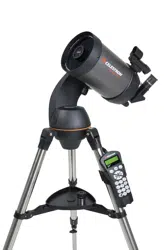Loading ...
Loading ...
Loading ...

18 I ENGLISH
Your NexStar telescope requires little maintenance. There are a few things to remember that will ensure your telescope
performs at its best.
TELESCOPE MAINTENANCE
Occasionally, dust and/or moisture may build up on the corrector plate of your telescope. Special care should be taken when
cleaning any instrument so as not to damage the optics.
If dust has built up on the corrector plate, remove it with a brush (made of camel’s hair) or a can of pressurized air. Spray at
an angle to the lens for approximately two to four seconds. Then, use an optical cleaning solution and white tissue paper to
remove any remaining debris. Apply the solution to the tissue and then apply the tissue paper to the lens. Low pressure strokes
should go from the center of the corrector to the outer portion. Do NOT rub in circles!
You can use a commercially made lens cleaner or mix your own. A good cleaning solution is isopropyl alcohol mixed with
distilled water. The solution should be 60% isopropyl alcohol and 40% distilled water. Or, liquid dish soap diluted with water (a
couple of drops per one quart of water) can be used.
If moisture condenses on the inside of the corrector, remove the accessories from the rear cell of the telescope. Place the
telescope in a dust-free environment and point it down. This will remove the moisture from the telescope tube.
To minimize the need to clean your telescope, replace all lens covers once you have finished using it. Since the rear cell is
NOT sealed, the cover should be placed over the opening when not in use. This will prevent contaminants from entering the
optical tube.
Internal adjustments and cleaning should be done only by the Celestron repair department. If your telescope is in need of
internal cleaning, please call the factory for a return authorization number and price quote.
CARE AND CLEANING OF THE OPTICS
“Seeing conditions” refers to the stability of the atmosphere and directly affects the amount of fine detail seen in extend-
ed objects. The air in our atmosphere acts as a lens that bends and distorts incoming light rays. The amount of bending
depends on air density. Varying temperature layers have different densities and, therefore, bend light differently. Light rays
from the same object arrive slightly displaced creating an imperfect or smeared image. These atmospheric disturbances
vary from time to time and place to place. The size of the air parcels compared to your aperture determines the “seeing”
quality. Under good seeing conditions, fine detail is visible on the brighter planets like Jupiter and Mars, and stars are
pinpoint images. Under poor seeing conditions, images are blurred and stars appear as blobs.
The conditions described here apply to both visual and photographic observations.
SEEING
Seeing conditions directly affect image quality. These drawing represent a point source
(i.e., star) under bad seeing conditions (left) to excellent conditions (right). Most often, seeing
conditions produce images that lie some where between these two extremes.
Loading ...
Loading ...
Loading ...
